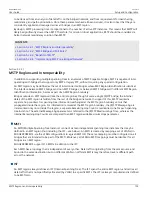
Chapter 5
Setup and Configuration
RUGGEDCOM ROS
User Guide
150
RSTP States and Roles
State
There are three RSTP states: Discarding, Learning and Forwarding.
The discarding state is entered when the port is first put into service. The port does not learn addresses in this
state and does not participate in frame transfer. The port looks for RSTP traffic in order to determine its role in
the network. When it is determined that the port will play an active part in the network, the state will change to
learning.
The learning state is entered when the port is preparing to play an active part in the network. The port learns
addresses in this state but does not participate in frame transfer. In a network of RSTP bridges, the time spent in
this state is usually quite short. RSTP bridges operating in STP compatibility mode will spend six to 40 seconds in
this state.
After
learning
, the bridge will place the port in the forwarding state. The port both learns addresses and
participates in frame transfer while in this state.
IMPORTANT!
RUGGEDCOM ROS introduces two more states - Disabled and Link Down. Introduced purely for purposes
of management, these states may be considered subclasses of the RSTP Discarding state. The Disabled
state refers to links for which RSTP has been disabled. The Link Down state refers to links for which
RSTP is enabled but are currently down.
Role
There are four RSTP port roles: Root, Designated, Alternate and Backup. If the bridge is not the root bridge, it must
have a single Root Port. The Root Port is the "best” (i.e. quickest) way to send traffic to the root bridge.
A port is marked as Designated if it is the best port to serve the LAN segment it is connected to. All bridges on the
same LAN segment listen to each others’ messages and agree on which bridge is the Designated Bridge. The ports
of other bridges on the segment must become either Root, Alternate or Backup ports.






























